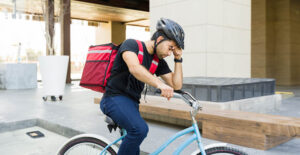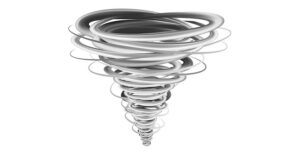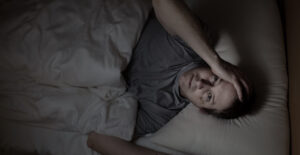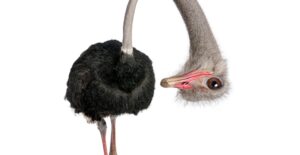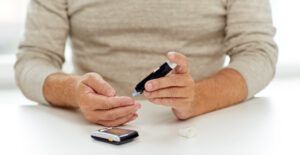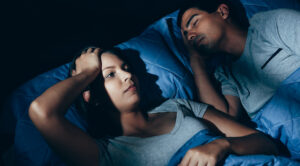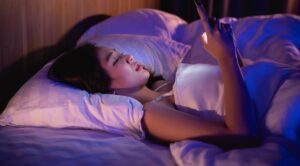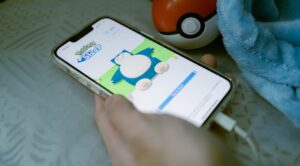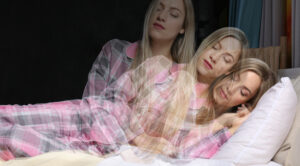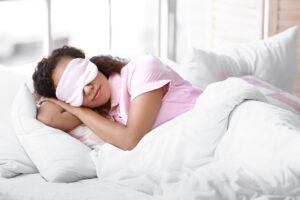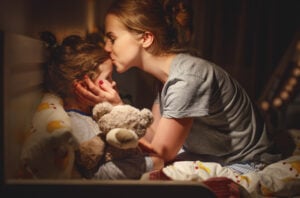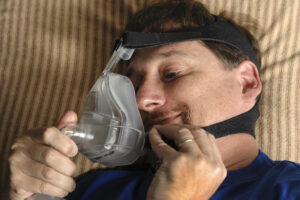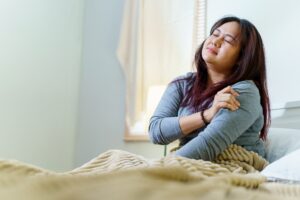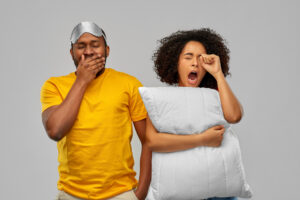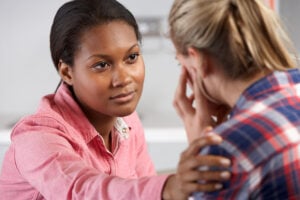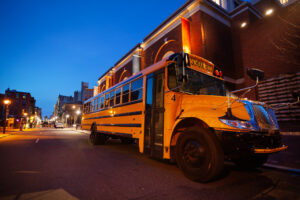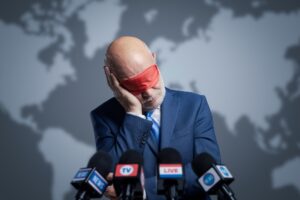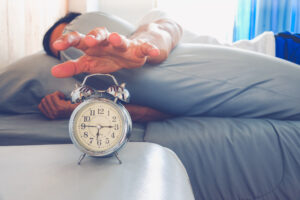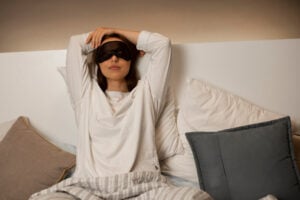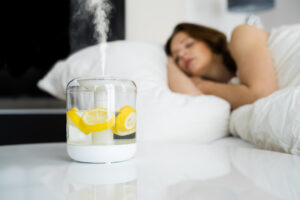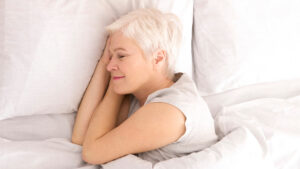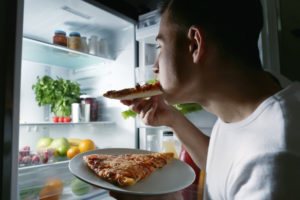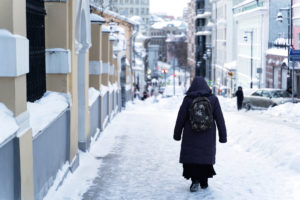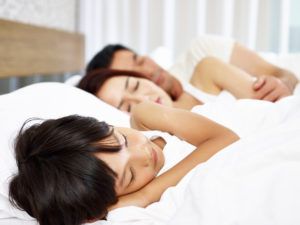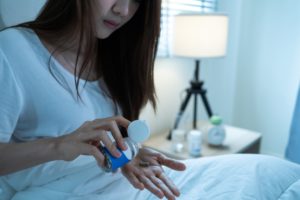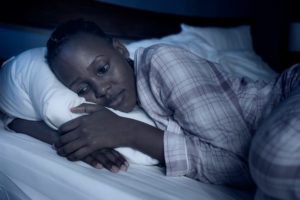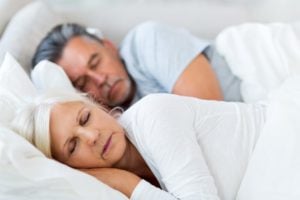Why Spooky Season Can be Frightful for Kids’ Sleep
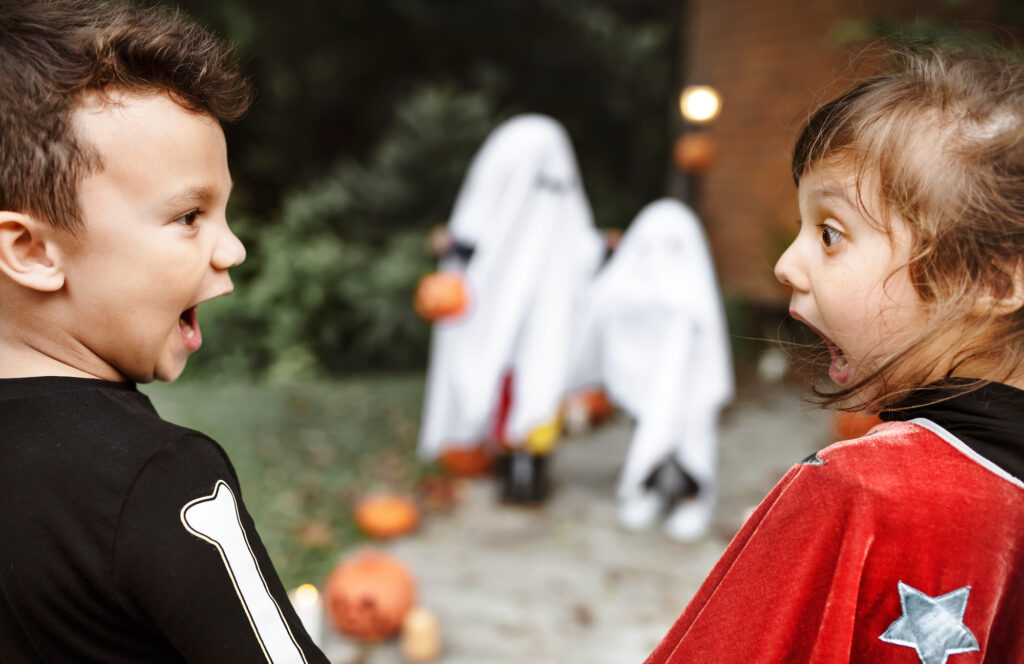
Brandy DeHuff, 41, took her son trick-or-treating for the first time when he was two years old and barely able to walk. The Colorado banker and mother of two school-aged children remembers approaching the neighbor’s house, decked out with flashing lights and fake cobwebs strung between porch posts. On the steps was a candy bowl with a witch claw that clamped down on her son’s hand when he tried to take candy.
“It terrified him!” DeHuff says. “If it hadn’t been for the lure of more candy, I’m sure he would have stopped then and there. He was definitely freaked out for the rest of the night and slept terribly.”
As Halloween nears, kids are growing more excited for the night that rewards jump scares and houses handing out full-size candy bars. For parents of young and teen children, Halloween can be a mixed bag of treats, especially when it comes to sleep.
“Late-night trick-or-treating, lots of sugar before bedtime, and all of the excitement of the holiday can disrupt children’s sleep schedules and make it harder for them to get a good night of sleep.”
Dr. Wendy M. Troxel, Behavioral Scientist, PhD
According to a recent study, eating junk food does, in fact, mess with our deep sleep. This is problematic for everyone, but particularly for teenagers who are already sleep-deprived.
“Late-night trick-or-treating, lots of sugar before bedtime, and all of the excitement of the holiday can disrupt children’s sleep schedules and make it harder for them to get a good night of sleep,” says Wendy Troxel, Ph.D., a senior behavioral scientist at the RAND Corp. and Sleepfoundation.org Medical Advisory Board member.
But just how badly does All Hallows’ Eve impact our kids’ sleep, and what can we do about it? Here’s what we found.
Do Candy Crushes Ruin Kids’ Sleep?
It’s no secret that kids love sugar. In fact, the average American eats roughly eight pounds of candy each year, with a higher estimate for kids. Those numbers spike on Halloween. Data show that Americans are projected to spend more than $3.5 billion on Halloween candy this year alone.
That’s a lot of sugar coursing through kids’ veins before bedtime. You might convince yourself that your kiddo will sleep it off after the excitement goes down, but experts suggest it’s not that easy. According to Dr. Nilong Vyas, pediatrician, sleep coach, and founder of Sleepless in NOLA, sugar is a stimulant.
“It can be challenging to fall asleep after Halloween, especially for children who have eaten a [lot of] candy,” Dr. Vyas says.
A Sleepfoundation.org survey from February 2023 shows that what we eat before bed matters. People who snack on candy before bed sleep about a half-hour less than those who choose healthier bedtime snacks. Chocolate bars and other chocolate-containing candy have caffeine, which can lead to sleep problems if eaten too close to bedtime.

Megan Curry, 39, is a Boston-based stay-at-home mom of four kids ranging from 2 to 14 years old. She notices her family struggling with unregulated sweets around the holiday. And at social gatherings, Curry has a tough time preventing others from giving her children extra candy. While she tries to keep her foursome in check after trick-or-treating, she often finds a few rogue candy wrappers tucked beneath the sheets of her children’s beds.
“The sugar highs and crashes almost always result in a change of sleep habits and some exceptionally challenging behavior during the days,” says Curry, noting that her older teenagers struggle, too. “With them, it’s become a conversation about accountability. A sugar high and a crash makes it tough to wake up in the morning.”
Ghosts and Goblins: A Recipe for Nightmares?
For other families, sugar is the lesser culprit. Instead, it’s the scary stuff and subsequent nightmares. In DeHuff’s family, scary movies are a big deal around Halloween, and the kids beg to watch them. But that doesn’t mean they should.
DeHuff’s eight-year-old daughter was hit the hardest. As a result, her sleep is a mess.
“She used to love the movie Coraline when she was younger and now she can’t watch it close to bed or if it’s dark out,“ says DeHuff of the animated horror film about a character who discovers a sinister fantasy world with button eyes beyond a secret door in her house. “The ‘other mother’ really freaks her out and she would tend to get out of bed and ask to sleep with us a lot.”
As soon as the calendar flips to September, it’s common to see spooky decorations come out–everything from oversized spiders and cobwebs to ghoulish pumpkin carvings and 12-foot skeletons hanging from trees, not to mention scary masks and creepy costumes with chainsaws. The onslaught of images can lead to sensory overload and be a lot for younger children to process.
“Decorations and images can spark a child’s imagination, potentially leading to sleep disturbances and nightmares,” Dr. Vyas explains.
Sweet Dreams are Made of This
There’s no other holiday like Halloween, so there is no reason to hide under the covers until November 1. Instead, frontload children with information so they head into the night prepared.
“It’s important for parents to talk to their kids, especially young ones, before heading out for trick-or-treating so they know what to expect,” says Troxel. “Remind them that costumes are not real and they’re just people playing dress up.”
DeHuff takes the same approach with her kids, trying her best to expose them to the realities behind the masks by showing them the details during the day when it’s bright and sunny outside. “We go to big box stores and check out how things work or show them that the items are fake and plugged in,” she says. “It helps a ton.”
Dr. Vyas and Troxel also recommend falling back on your usual bedtime routine to calm your children and help them find a bit of normalcy amidst the festivities. “Set some limits as to when the trick-or-treating is going to end so there is time for the child to unwind, count their candy, and then settle in,” Troxel says.
With teens, exhaustion is another problem to consider since most older teens stay up later that night.
“Parents should set reasonable limits on how late their teens stay out on Halloween and be mindful that even older children can find some Halloween costumes or decorations scary,” says Troxel, particularly mentioning haunted houses. “Talking to your teens in advance to find out if they are feeling anxious and some strategies to cope with that, can be very helpful.”
Got a hot tip? Pitch us your story idea, share your expertise with SleepFoundation.org, or let us know about your sleep experiences right here.
References
4 Sources
-
Brandão, L. E. M., Popa, A., Cedernaes, E., Cedernaes, C., Lampola, L., & Cedernaes, J. (2023). Exposure to a more unhealthy diet impacts sleep microstructure during normal sleep and recovery sleep: A randomized trial. Obesity (Silver Spring, Md.), 31(7), 1755–1766.
https://pubmed.ncbi.nlm.nih.gov/37245331/ -
Winsler, A., Deutsch, A., Vorona, R. D., Payne, P. A., & Szklo-Coxe, M. (2015). Sleepless in Fairfax: the difference one more hour of sleep can make for teen hopelessness, suicidal ideation, and substance use. Journal of youth and adolescence, 44(2), 362–378.
https://pubmed.ncbi.nlm.nih.gov/25178930/ -
Duyff, R. L., Birch, L. L., Byrd-Bredbenner, C., Johnson, S. L., Mattes, R. D., Murphy, M. M., Nicklas, T. A., Rollins, B. Y., & Wansink, B. (2015). Candy consumption patterns, effects on health, and behavioral strategies to promote moderation: summary report of a roundtable discussion. Advances in nutrition (Bethesda, Md.), 6(1), 139S–46S.
https://pubmed.ncbi.nlm.nih.gov/25593156/ -
Dighe, T. Planned annual Halloween expenditure in the United States in 2023, by item. (2023, September 25). Statista., Retrieved October 4, 2023 from
https://www.statista.com/statistics/275736/annual-halloween-expenditure-in-the-us-by-item/





